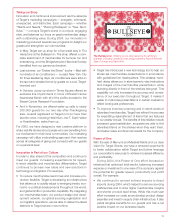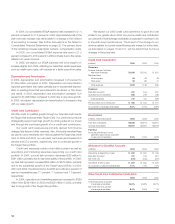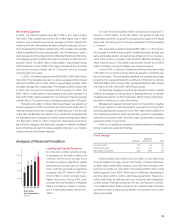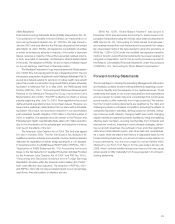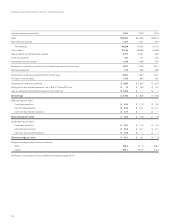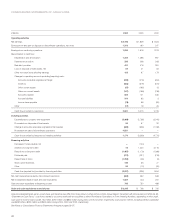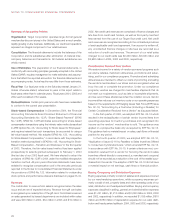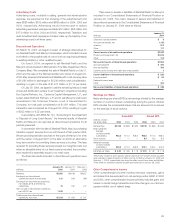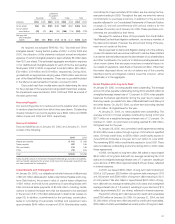Target 2004 Annual Report Download - page 25
Download and view the complete annual report
Please find page 25 of the 2004 Target annual report below. You can navigate through the pages in the report by either clicking on the pages listed below, or by using the keyword search tool below to find specific information within the annual report.
23
2004 Adoptions
Financial Accounting Standards Board (FASB) Interpretation No. 46,
“Consolidation of Variable Interest Entities, an interpretation of
Accounting Research Bulletin No. 51” (FIN No. 46) was issued in
January 2003 and was effective the first reporting period that ended
after March 15, 2004. FIN No. 46 requires the consolidation of entities
in which an enterprise absorbs a majority of the entity’s expected
losses, receives a majority of the entity’s expected residual returns,
or both, as a result of ownership, contractual or other financial interest
in the entity. The adoption of FIN No. 46 did not have a material impact
on our net earnings, cash flows or financial position.
The Medicare Prescription Drug, Improvements and Modernization
Act of 2003 (The Act) was signed into law in December 2003. The Act
introduces a prescription drug benefit under Medicare (Medicare Part D),
as well as a federal subsidy to sponsors of retiree health care benefit
plans that provide a prescription drug benefit that is at least actuarially
equivalent to Medicare Part D. In May 2004, the FASB issued Staff
Position (FSP) No. 106-2, “Accounting and Disclosure Requirements
Related to the Medicare Prescription Drug, Improvement and
Modernization Act of 2003.” This FSP is effective for interim or annual
periods beginning after June 15, 2004. Final regulations that would
define actuarial equivalency have not yet been issued. However, we
have made a preliminary determination that our plans will be actuarially
equivalent. As a result, we recorded a reduction in our accumulated
post-retirement benefit obligation of $7 million in the third quarter of
2004. In addition, the expense amounts shown in the Pension and
Postretirement Health Care Benefits Note reflect a $1 million reduction
due to the amortization of the actuarial gain and reduction in interest
cost due to the effects of the Act.
The American Jobs Creation Act of 2004 (The Act) was signed
into law in October 2004. The Act introduces a tax deduction for
qualified production activities and a special one-time dividend received
deduction for repatriation of certain foreign earnings to a U.S. taxpayer.
In December 2004, the FASB issued Staff Position (FSP) No. 109-1,
“Application of FASB Statement No. 109, Accounting for Income
Taxes, to the Tax Deduction on Qualified Production Activities Provided
by the American Jobs Creation Act of 2004” and FSP No. 109-2,
“Accounting and Disclosure Guidance for the Foreign Earnings
Repatriation Provision within the American Jobs Creation Act of 2004,”
both were effective upon issuance. The adoption of FSP No. 109-1
and FSP No.109-2 did not have a material impact on our net earnings,
cash flows, financial position or effective tax rate.
SFAS No. 123R, “Share-Based Payment” was issued in
December 2004 and eliminates accounting for share-based com-
pensation transactions using the intrinsic value method prescribed in
APB Opinion No. 25, “Accounting for Stock Issued to Employees,”
and requires instead that such transactions be accounted for using a
fair-value-based method. We have elected to adopt the provisions of
SFAS No. 123R in 2004 under the modified retrospective transition
method. All prior period financial statements have been restated to
recognize compensation cost in the amounts previously reported in
the Notes to Consolidated Financial Statements under the provisions
of SFAS No. 123, “Accounting for Stock-Based Compensation.”
Forward-looking Statements
This Annual Report, including the preceding Management’s Discussion
and Analysis, contains forward-looking statements regarding our per-
formance, liquidity and the adequacy of our capital resources. Those
statements are based on our current assumptions and expectations
and are subject to certain risks and uncertainties that could cause
actual results to differ materially from those projected. We caution
that the forward-looking statements are qualified by the risks and
challenges posed by increased competition (including the effects of
competitor liquidation activities), shifting consumer demand, chang-
ing consumer credit markets, changing health care costs, changing
capital markets and general economic conditions, hiring and retaining
effective team members, sourcing merchandise from domestic and
international vendors, investing in new business strategies, achiev-
ing our growth objectives, the outbreak of war and other significant
national and international events, and other risks and uncertainties.
As a result, while we believe that there is a reasonable basis for the
forward-looking statements, you should not place undue reliance on
those statements. You are encouraged to review Exhibit (99)C
attached to our Form 10-K Report for the year-ended January 29,
2005, which contains additional important factors that may cause
actual results to differ materially from those projected in the forward-
looking statements.


